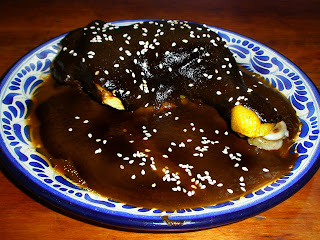 T
Two shy
campesinas, attired in home-made cotton dresses with
rebozos draped over their shoulders, waited patiently at the counter of the
carnicería. When their turn came they asked for “una cabeza, por favor” (“a head, please”). The butcher looked at them quizzically (as did I) and asked what sort of head they needed. Their answer produced a huge, grinning pig’s head, which made even them laugh. “What will you make with it”, I queried? “Pozole, of course!” they replied.
Pozole, (pronounced poh-SOH–lay), is a quintessential Mexican comfort food--a soup fit for a king. Basically, it’s a hearty meat broth, laced with chili and augmented with hominy (known as
cacahuazintle in Mexico). The hominy is prepared by a process called
nixtamalización, that is, soaked in lime, as for corn tortillas, which softens the kernels. It is sometimes eaten at home, often for festive occasions – my friend Daniel reported celebrating
las fiestas patrias, the evening of the 15th of September, at the home of his in-laws with a big family pozole. But more often it is enjoyed at pozolerías, restaurants devoted to this sumptuous dish, or at market and street stalls.
The word pozole comes from the Nahuatl
potzonti or
posolli, meaning to boil or bubble, and versions of it are made all over Mexico. A similar thick soup was mentioned in the chronicles of the early Spanish missionary Fray Bernardino de Sahagún. He reported Moctezuma eating pozole that contained thigh meat from a sacrificed warrior in a ceremony honoring the sun god, Huitzilopotzli. Today’s version is usually made with pork (the pig’s head gives the best flavor, although simple meat and bones will do) and garnished with shredded lettuce, radishes, onion, oregano and perhaps
chicharrón (pork skin), tostadas and more chile—the ‘garnishes’ can sometimes fill half the bowl. There are many kinds of pozole in Mexico, although the state of Jalisco is home to the most famous variety,
pozole blanco. In Guerrero green pozole is common, thickened with pumpkin seeds. I much prefer the third version, the rich chili-red
pozole rojo, associated with Michoacán .

Rick Bayless, the tireless chef, restaurateur, and host of the PBS series, ‘Mexico, One Plate at a Time’, is author of Authentic Mexican, from which I adapt the following recipe for Pozole Rojo (for home cooks lucky enough to reside in Mexico):
.
Pozole Rojo, Michoacán style
Yields 10-12 large servings
1 k. prepared cacahuazintle (available at any mercado, or packaged at the supermarket)
½ small pig’s head (about 2 k.), scrubbed and halved, OR 3 medium pigs’ feet (about 1 k. total), well scrubbed and split lengthwise
800 g. meaty pork neck bones
800 g. lean boneless pork shoulder, in a single piece
1 large onion, finely chopped
4 large garlic cloves, peeled and minced
4 large dried chiles anchos (about 60g total)
4 large dried chiles guajillos (about 30g total)
salt to taste (about a tablespoon)
For the condiments:
½ medium-sized head of cabbage, cored and very thinly sliced
(iceberg lettuce can be substituted for the cabbage)
8-10 radishes, thinly sliced
1-½ cups onion, finely chopped
About 1/3 cup dried oregano
3 or 4 limes, cut in halves
15 -20 tostadas, preferably home fried.
ground chile piquín, available in the market, where moles and spices are sold
1. Put the meats, bones, cacahuazintle, onion and garlic into a pot with 7 liters of water.
Cook until tender – the corn will start to “blossom”--that is, to open up at one end.
2. Toast the chiles, a few at a time, on a comal or griddle, pressing down with a spatula (20 seconds or less on each side should be sufficient-- be careful not to burn them or they will be bitter).
Remove the stems, cores and seeds, and submerge chilies in a bowl of hot water. Soak for 20-30 minutes. Drain, place in a blender jar and add ½ cup water; blend until smooth. Strain through a medium-mesh sieve into the simmering soup and mix well.
Generously season with salt and let simmer for an hour or so.
3. Finishing the soup:
Remove the meats from the broth and when cool enough to handle, cut off the usable meat from the bones and chop into 1-2 cm pieces, shredding the shoulder pieces.
Just before serving, season the soup with salt to taste. Add the meat to the pot and let simmer a few minutes to reheat.
Serve in pozoleros, deep soup bowls, with all the accompaniments set up on the table so that each diner can help himself. The tostadas are a crunchy accompaniment to enjoy between big spoonfuls of the soup.
If you would rather have someone else deal with the pig parts for you, there are many excellent pozolerías around town; a few of my favorites are:
Pozolería La Casa de ToñoSabino 144, Colonia Santa Maria La Ribera
Tel. 2630-1084
Open Monday - Saturday 9 AM - 11 PM, Sunday until 10 PM
Two blocks west of the main plaza of Santa María La Ribera is the extraordinary Casa de Toño, a pozolería set in a 19th-century mansion. Thick, red pozole with all the garnishes is the house specialty, although
sopes, tostadas and other
antojitos are also offered. At $34 pesos for a grande, this is a bargain meal. Lovely rooms decorated with murals and original mosaic floors create a pleasant, old-time atmosphere.
Pozolería TizkaCalle Zacatecas 59, between Córdoba and Mérida, Colonia Roma
Open daily 12 - 10 PM
I used to live upstairs from this bustling place in the heart of La Roma, so I ate here a lot. They specialize in hearty and delicious pozole verde from the state of Guerrero. It is similar to the red kind, but instead of red chilies, ground pumpkin seeds provide the thick, green soup base, which has a nutty, earthy flavor. The tostadas here are especially fresh and crisp, and redolent of corn flavor. Also offered is pozole blanco in a simple clear broth. There is often live guitar music at comida
time.
Doña YoliCalle San Ildefonso 42 , near Calle Argentina (go up the staircase at the back of the building)
Open Monday - Saturday, 2 - 6 PM
The dark, rich, chili-infused broth of this pozole contains pork, maize, and comes with all the trimmings described above; crisp tostadas are served on the side, all for 35 pesos. It’s a convenient stop before or after a visit to the spectacular Museo de San Ildefonso, whose exit door is just across the street (the entrance is on Justo Serra, around the block).
Mercado de ComidasCalle Higuera 6, Coyoacán center
open approximately 2-11PM, daily
This well known garage-like space, a block from Coyoacán’s central Plaza, is open late. Most people stop here for a rich pozole at the stand right in the center. The deep-fried quesadillas sold
here are fresh and delicious.
PotzollcalliAv. 5 de Mayo, Centro
open daily 7:30AM-11:30PM
The pozole at this unpronounceable chain is a little blander than many, but perfectly acceptable, for those who prefer to play it safe--the restaurants are very clean. There are branches all over the country: see their website for locations (www.potzollcalli.com.mx)
This article has previously appeared in The News, Mexico
 The Condesa “Mercado sobre Ruedas” ( market on wheels) appears every Tuesday morning in the streets surrounding the infamous Edificio Condesa, AKA “Peyton Place” so-named because of the notorious scandals of its artsy residents. There are other attractive daily markets throughout the city, but none beat this one for pure picturesque-ness. The fruits and vegetables, many of them exotically tropical, are gleaming and radiant, piled high in neat , bijou–like displays. Sweet and perfumy aromas waft about, inviting you to buy with your nose as well as your eyes. “Try some papaya!” encourages a vendor as you pass, “PAPAYA!!!” he pleads, in disbelief that anyone could possibly pass up such a treat. I took my sister-in- law Kathryn here, just before her return to Florida. As she passed the fruit aisle, eyes half closed, taking in the bouquet of sweet perfume, a defeated look came over her face. “It’s just not fair” is all she could utter.
The Condesa “Mercado sobre Ruedas” ( market on wheels) appears every Tuesday morning in the streets surrounding the infamous Edificio Condesa, AKA “Peyton Place” so-named because of the notorious scandals of its artsy residents. There are other attractive daily markets throughout the city, but none beat this one for pure picturesque-ness. The fruits and vegetables, many of them exotically tropical, are gleaming and radiant, piled high in neat , bijou–like displays. Sweet and perfumy aromas waft about, inviting you to buy with your nose as well as your eyes. “Try some papaya!” encourages a vendor as you pass, “PAPAYA!!!” he pleads, in disbelief that anyone could possibly pass up such a treat. I took my sister-in- law Kathryn here, just before her return to Florida. As she passed the fruit aisle, eyes half closed, taking in the bouquet of sweet perfume, a defeated look came over her face. “It’s just not fair” is all she could utter.



































